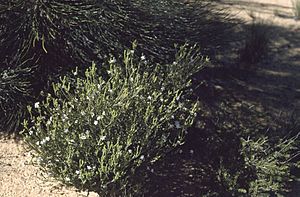Philotheca thryptomenoides facts for kids
Quick facts for kids Philotheca thryptomenoides |
|
|---|---|
 |
|
| Near Beacon | |
| Scientific classification | |
| Genus: |
Philotheca
|
| Species: |
thryptomenoides
|
| Synonyms | |
|
|
Philotheca thryptomenoides is a beautiful flowering plant that belongs to the Rutaceae family, which also includes citrus fruits! This special plant is only found in the south-west part of Western Australia. It's a small, bushy plant, often called an undershrub. It has unique oval or club-shaped leaves and pretty white flowers. Each flower has a reddish-brown stripe down the middle and grows by itself at the end of a branch.
Contents
What it Looks Like
Philotheca thryptomenoides is a small, bushy plant. It usually grows to about 50 centimeters (about 20 inches) tall. Its branches are smooth and can be dark brown or even black.
Leaves and Flowers
The leaves of this plant are quite interesting. They are shaped like an oval or a small club, and they are about 1.5 to 3 millimeters long. The top surface of the leaves is flat.
The flowers are white with a reddish-brown stripe in the middle. They grow one by one at the very end of the plant's small branches. Sometimes, the flowers grow directly on the stem (this is called sessile). Other times, they have a very short stalk, or pedicel, which is only up to 2 millimeters long.
Flower Parts
Each flower has five egg-shaped parts called sepals, which are about 2 to 3 millimeters long. These sepals protect the flower when it's a bud. The five white petals are narrowly egg-shaped and about 6 millimeters long. They have that distinct reddish-brown stripe. Inside the flower, there are ten stamens. Stamens are the parts that produce pollen. These stamens are separate from each other and are covered in tiny hairs.
When it Flowers
This plant usually blooms between July and September. After the flowers, small fruits grow, which are about 1.5 to 2 millimeters long.
How it Got its Name
This plant was first described in 1920 by a scientist named Spencer Le Marchant Moore. He first called it Erisotemon thryptomenoides. Later, in 1998, another scientist named Paul Wilson changed its name to Philotheca thryptomenoides. This new name is the one we use today.
Where it Lives
You can find Philotheca thryptomenoides growing in a type of bushy area called shrubland. It prefers to grow in heavy soil. This plant is found in a specific part of Western Australia, in the area between Merredin and Wubin.
Is it Safe?
The Government of Western Australia's Department of Parks and Wildlife has looked at this plant. They have classified Philotheca thryptomenoides as "not threatened." This means that there are enough of these plants in the wild, and they are not currently in danger of disappearing.

